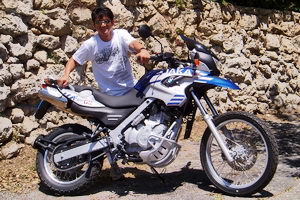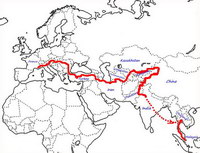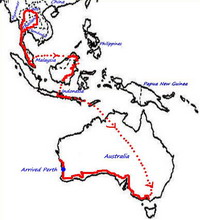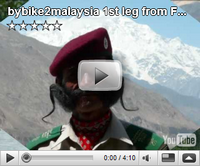Borneo’s incredible jungle roads
Current location : Gattières, France
2nd day midnight : this heavy truck could not get out despite being pulled by 2 other trucks simultaneously. The road is blocked. We spent our 2nd evening here … Iwan, the driver of the truck I hitched a ride with, had wanted to drive all night.
03/Mar/09 to 06/Mar/09 : From Berau to Sangatta, E. Kalimantan
Must remember this day, 03/Mar/09. As the taxiboat pulled out of Tarakan that morning, with my bike safely tugged inside its belly, I was probably the happiest overlander biker (if there were any others) in Borneo. In short, there was a feeling everything was wonderful after the anxieties and showdown of last 3 days with immigration in Tarakan – now, I’ve escaped it !! Youpie, take that !
The weather was good. To get to Tanjung Selor, the taxiboat snakes its way 5hrs through the peaceful and natural wild swampland of NE Borneo. Occasionally, marine and wading birds, fish spouts, and man-made fishing trap structures would crossed our path. As we approached the mouth of river Kayan, where Tanjung Selor is located, individual wooden stilt houses – partly built on land and partly over water – came into view against background of coconut trees and rainforest. My first close-up panoramic view of a remote village on mainland Borneo. It was an exciting moment. I guess for any tourist who venture this far, this sight beats the hell out of city skylines.
At Tanjung Selor, Hadjiran’s brother, Chang, was waiting at the wharf (Hadjiran was worried for me, so he called in his brother to assist my arrival). First thing Chang said in bahasa was “I’m local, don’t worry, nobody is going to dare to mess with you here in our village”. Not only did I have a “bodyguard”, Chang also offered a place to stay that evening so that I can park the bike in a safe compound. I soon learned that the only road south was through the unsealed jungle roads between Berau (also known as Tanjung Redep) and Sangatta, which he says vehicules normally take 3 days (if it does not rain) to 7 days (if it rains). Locals here calculate travel distances in terms of days, depending on the weather, road and sea conditions. The actual distance of 400+km don’t really mean much to them.
”Big mess when it rains, some people are stuck up to 3 days inside cars & buses, so carry some food. No food in the middle of jungle. Go slowly, your enduro bike can make it” Chang advised. This is the 1st time I’ve had hard info about my next destination. Of course, I did not comprehend what Chang really meant (3 to 7 days to cover 400+km seemed like a long time) – after all, the rare images I’ve seen on the net of jungle roads in Borneo just show its mystical side, hard to imagine what it is like in reality. I do carry camping gear and 1 day food. This coming stretch promised to be a real adventure – this time in mud !!
Early next morning, after thanking Chang for his hospitality, crossed my fingers that it don’t rain, I rode the 120km south to Berau on good narrow sealed road. Next to the road, the rainforest trees are long gone, replaced by few small farmlands (mostly banana) along the way. As advised, I filled up petrol at Berau, got directions to where the jungle road begins as my GPS indicates no road. The locals who saw me on a bulky bike were full of smiles and encouragement. I suppose they are not used to seeing a foreign biker coming into town.
So far so good ?? Well, it was good going for the first 40km or so on hardened unsealed road, with potholes left by trucks – no problem with that, then the rain came. Travel speed was reduced to less than 40km/hr, then the mud sections appeared and max. speed reached 5 to 10km/hr. There was no adhesion in mud, the bike was struggling and skidding. My 240kg bike & luggage seemed like 500kg now. Rain outside, sweat inside ; making a few metres advance each time was quite a tiring exercise. Faced with impasse, I decided to wait under the rain – wait it out or maybe I’ll have to camp here, or take the 3 to 7 days it takes to cross the 400km jungle !!
Soon, I found I was not alone in the jungle. Every half hour or so, a private taxi cramped with passengers or a truck would pass by. This was the only road linking north / south, that once was a private logging road. The Indonesian authorities have shut down all logging activities (illegal or not) 6 years back due to large scale deforestation and corruption. Its now simply a jungle road, almost unmaintained. As there are no alternative roads, the locals and traders continue to use it to link their communities, despite the dangers.
With a twist of luck, a fully loaded taxi and an empty Mitsubishi truck, each coming from opposite directions stopped next to me. The taxi driver explained they’ve been in the jungle 3 days and nights since Sangatta because of rain. That vehicles are having problems to move in many sections so its better I turn back to Berau until the road dries up, or piggy-ride on the truck. Will the road dry up ?? A bit of negotiation later, for cigarette money as they called it, truck driver Iwan and his 2 assistances (Aldi and Ismail) agreed to take us onboard. We spent the next 3 days and many hours at night riding through difficult, slippery mud filled terrain, full of holes and trenches. The road was forever steep, up and down, and up and down. This was really the toughest and worst road ever up to now on my way to Australia. No regrets doing the piggy riding.
Over the next 3 days, I observed how die-hard, unafraid and bonded the Indonesian drivers plowing this jungle road have become. They push their cars, buses or trucks to its mechanical limits. They relied on their fellow drivers to pull them out of mud trenches. Some mud trenches are amazingly truck deep and uncomfortably long. The drivers joke at their misfortune when a vehicle is stuck. The passengers of private cars, except for women and children, too had to get out to help push or pull their vehicules out of the mud. We had decent food and sleep bunks for 2 nights in a “warung” (roadside foodstall), and spent one night out on the truck because we got caught up in a “traffic jam” in the middle of the jungle. Yet, the Indonesians I met remained remarkably calm.
A bit of statistics. We traveled about 16hrs/day (2 hrs for lunch & dinner, 6 hrs for sleep & breakfast) where our truck was either moving or waiting at trenches. It took 3 days to cover the 400km Berau / Sangatta stretch. Our average speed works out to be 8.3 km/hr – an incredibly slow speed. The locals here are right to calculate their travel distance in terms of days.
On the lighter side, Iwan joked that when he started this job 6 years ago, the jungle was wild and there were not many vehicules doing the jungle run. Sometimes, Orang Utans would come up beside the road and stretch out their hands for handouts when they hear a truck coming. Sadly, he said it’s the opposite nowadays – some people will make a hole in the road, forcing vehicules to slow down and stretch out their hands for handouts !!
A really memorable experience.









